What It’s Like to Live in the World’s Largest Urban Areas
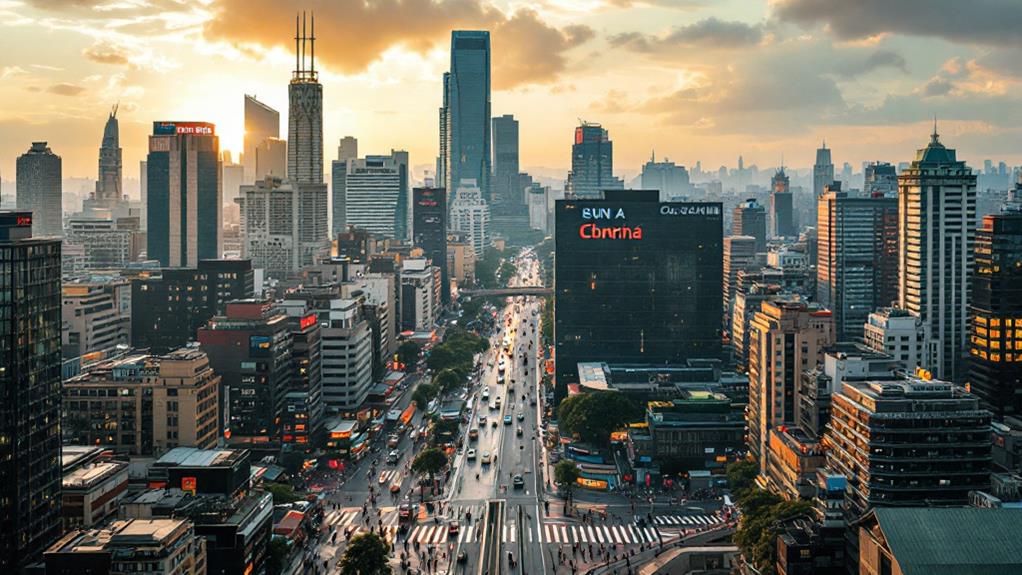
Living in the world's largest urban areas envelops you in diverse cultures and lively social scenes. You can savor international cuisines and enjoy an array of festivals. Economic opportunities abound, offering career growth in thriving city environments. However, housing challenges persist, often leading to high costs and cramped living conditions. Efficient public transport eases commuting, yet environmental issues like air pollution can affect your health. Despite potential isolation, community groups offer ways to connect and engage. Balancing work and leisure is crucial as you navigate the fast-paced lifestyle. Each aspect of urban life enriches your understanding of city living.
Diverse Cultural Experiences
Amidst the lively energy of the world's largest urban areas, you'll find a rich tapestry of diverse cultural experiences that truly define city life. With cities like Tokyo and New York, you're surrounded by a lively mix of cultures, languages, and traditions. These urban areas boast a high population density, providing a unique opportunity for you to engage with a multitude of cultural events. From festivals and exhibitions to live performances, there's always something happening to capture your interest and broaden your cultural horizons.
The culinary diversity in these metropolises is nothing short of extraordinary. Regardless of your craving for sushi, tacos, or a classic New York bagel, the variety of international cuisines available reflects the multicultural fabric of urban life. Each meal becomes an opportunity to connect with the world without leaving the city limits.
Moreover, the concentration of museums, galleries, and theaters offers you access to both local and global art scenes. This abundance of cultural institutions enriches your appreciation for the arts and fosters a lively community spirit. In these thriving cities, diverse cultural experiences are not just a feature but a defining aspect of everyday life.
Urbanization's Impact on Housing
Urbanization's impact on housing is undeniable, as it drives up the demand for living spaces in large cities, often resulting in skyrocketing rent and property prices. As urban sprawl continues, the housing crisis becomes a pressing issue for the urban population living in these areas. You'll find that with more people flocking to cities for job opportunities, competition for housing intensifies, leading to smaller apartments becoming the norm. This situation often forces many to live in substandard, slum-like conditions due to the lack of affordable housing solutions.
With limited space in densely populated urban environments, cities struggle to provide adequate infrastructure and amenities. The rapid influx of residents can make it challenging to keep pace with housing demands, further exacerbating the crisis. According to UN projections, if no significant changes occur, urbanization could result in an extra 2 billion people living in slum-like conditions by 2050. This highlights the urgent need for groundbreaking affordable housing solutions to address these challenges. As you navigate life in these vibrant urban areas, understanding the housing dynamics is essential to adapting and possibly advocating for changes that can improve living conditions for all.
Navigating Public Transportation
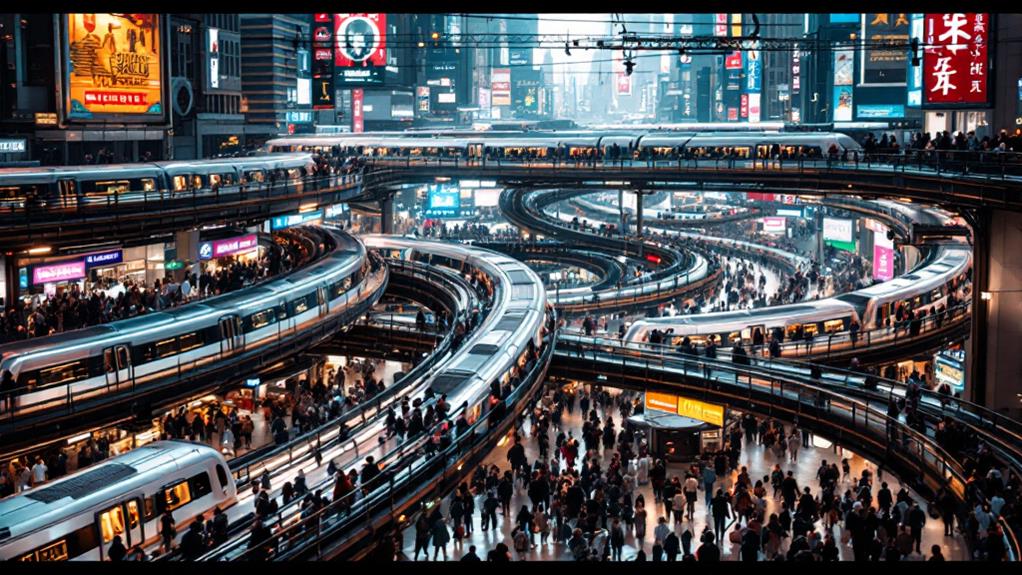
While living in the world's largest urban areas, maneuvering public transportation becomes a crucial part of daily life. With higher populations and lively economic activity, these cities often boast extensive transit systems like buses, subways, and trams. These networks provide millions with efficient and accessible transportation options, reducing the need for personal vehicles and cutting down on costs. Despite these advantages, not everyone enjoys the same level of access to public transit. In 2022, only 51.6% of the global urban population had easy access, underscoring the disparities in transportation infrastructure.
Navigating these urban areas means understanding the integration of motorized transport with walking and cycling. It's not just about hopping on a bus or a train; it's about seamlessly moving through the cityscape. Cities like New York and Chicago offer diverse transit choices, leading the way in public transportation innovation:
- Encouraging walking and cycling for short distances.
- Enhancing connectivity between different transit modes.
- Prioritizing sustainability in transit planning.
- Reducing the reliance on personal vehicles.
As cities endeavor to improve public transit, these efforts contribute greatly to the quality of life, making urban living more sustainable and interconnected.
Economic Opportunities in Cities
Cities are lively hubs of economic activity that offer vast opportunities for career growth and development. When you live in an urban area, you're surrounded by a concentration of large corporations that considerably increase job availability. Regardless of your interest in corporate, retail, or the medical sectors, your options are abundant. The higher salaries often associated with city jobs reflect the economic opportunities available in these densely populated regions.
Networking is another crucial aspect of urban living. With a dense population, you can easily attend job fairs and professional events, making valuable connections that might not be as accessible in rural areas. These interactions can open doors to new opportunities and career advancements.
Moreover, the economic activity density in cities often leads to better living standards. You'll likely enjoy improved access to vital services like electricity, sanitation, and clean drinking water. Urbanization also strongly correlates with GDP per capita, which means you're living in an environment with robust economic growth potential. This leads to higher living standards and reduced child malnutrition rates, demonstrating the positive impact of urban economic dynamics on your everyday life.
Environmental Challenges
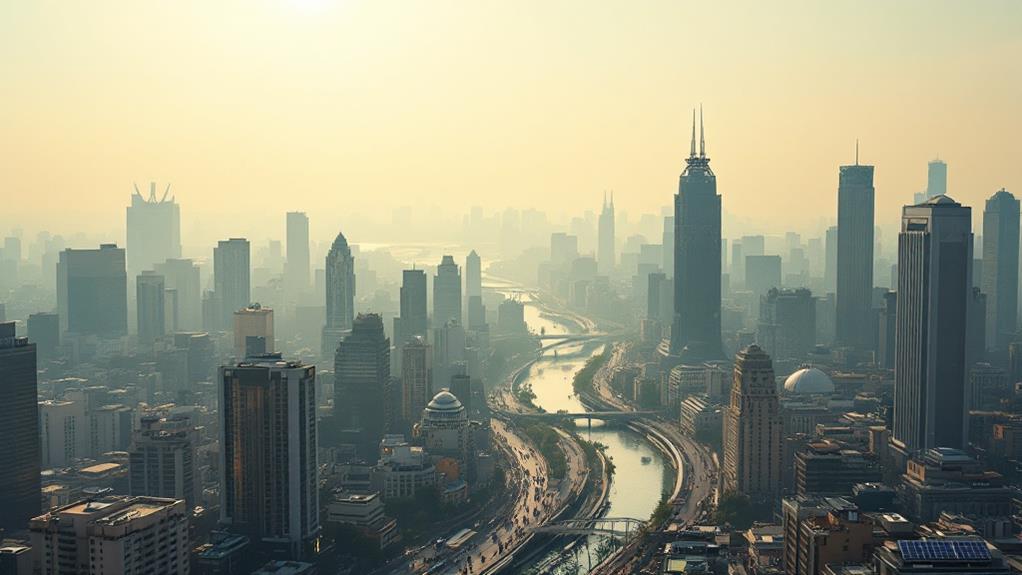
The rapid growth of urban areas brings significant environmental challenges that demand urgent attention. As populations concentrate, these areas contribute to approximately 70% of global greenhouse gas emissions. You'll notice how air pollution becomes a critical issue, particularly in low- and middle-income countries where air quality levels are poorer than in high-income regions. This not only affects public health but also poses a threat to sustainability.
Meanwhile, over 1.1 billion people live in slums or slum-like conditions, lacking adequate access to clean water, sanitation, and waste management. This exacerbates environmental degradation and complicates efforts to improve living conditions. Urbanization also takes its toll on green spaces and biodiversity. As cities expand, natural habitats are often replaced by infrastructure, leading to ecological imbalances that further challenge urban environments.
- Air pollution: Affects public health and sustainability
- Slums: Over 1.1 billion people face inadequate infrastructure
- Green spaces: Loss due to urbanization and infrastructure growth
- Environmental degradation: Exacerbated by poor waste management
The demand for energy in these large urban centers also drives increased reliance on non-renewable resources, worsening air quality and intensifying climate change concerns.
Community and Social Life
Vibrancy defines life in the world's largest urban areas, where community and social interactions thrive amid the hustle and commotion. You'll find a kaleidoscope of cultural diversity reflected in countless festivals and social gatherings, inviting you to participate in traditions from around the globe. This rich tapestry of events not only improves your community engagement but also raises your standard of living.
Urban areas are lively with high population densities, which can create a unique blend of anonymity and connection. While you might experience increased chances for networking, you could also encounter feelings of isolation. Fortunately, many cities host community organizations dedicated to fostering connections and addressing challenges like housing and healthcare. Through these initiatives, you'll uncover opportunities to volunteer and support your neighbors.
Public spaces and parks in metropolitan areas serve as crucial venues for social interaction and recreation. These settings encourage spontaneous meetups, friendly sports matches, and community events that strengthen neighborhood ties. Regardless of whether you're exploring a local park or attending a cultural festival, these public spaces provide a fundamental backdrop for social life. Embracing the dynamic social scene of urban areas enriches your experience and strengthens your sense of belonging.
Balancing Work and Leisure
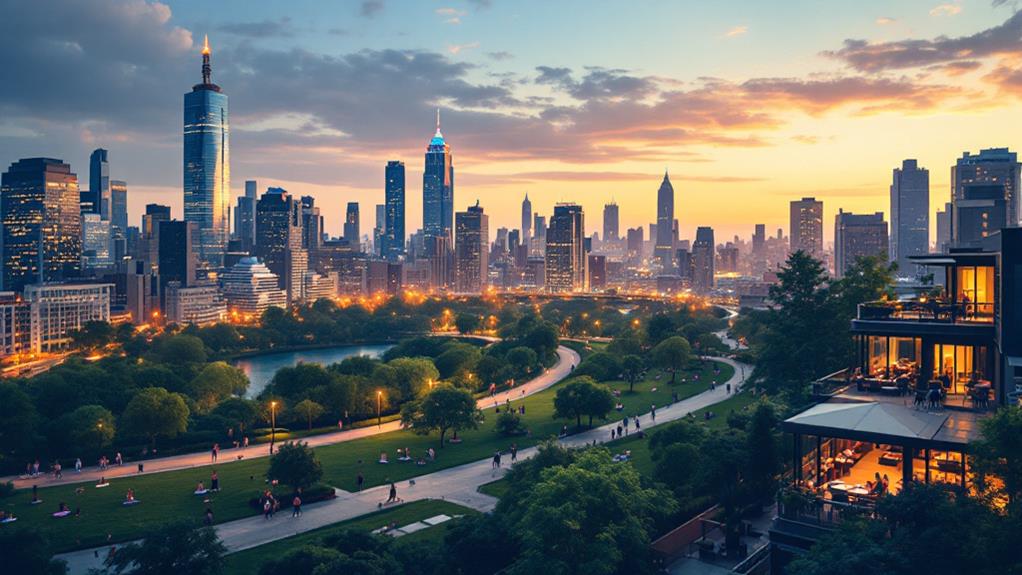
Maneuvering urban work-life dynamics can be both exhilarating and demanding. The lively environment in urban areas buzzes with opportunities, yet this comes with the challenge of maintaining a work-life balance. With the high cost of living, you'll need to manage your finances well to enjoy the diverse entertainment options available. Major cities pack a punch with cultural experiences, offering everything from eclectic dining to thrilling nightlife. But how do you make the most of it?
- Utilize public transportation: It's a game-changer in urban areas, making it easier and quicker to reach entertainment spots without the hassle of traffic or parking.
- Plan your leisure time: With so many entertainment options, organizing your schedule guarantees you catch that concert or try that new restaurant.
- Find a financial equilibrium: Balancing the cost of living with leisure expenses requires smart budgeting to enjoy city life fully.
- Create a personal sanctuary: Noise pollution and limited space are hurdles, so carve out a cozy nook at home to unwind.
Navigating the urban landscape successfully means leveraging what cities offer while creating a sustainable routine that suits your lifestyle.
Innovations in Urban Living
Amidst the evolving landscape of urban living, cities worldwide are embracing innovations that redefine how we experience city life. Urban areas are adopting smart growth initiatives to create walkable communities and sustainable practices, effectively managing suburban sprawl and improving quality of life. These initiatives aim to make your daily life more convenient and environmentally friendly.
Public transportation is a key focus, with cities implementing extensive transit systems that reduce reliance on personal vehicles. You'll find that these systems not only improve accessibility to amenities but also contribute to a cleaner urban environment. Furthermore, cities are integrating green spaces into their planning, targeting 45-50% of urban land for open public spaces. These areas promote community engagement and offer environmental benefits, providing you with a healthier living environment.
Technology-driven solutions are also playing a significant role in transforming urban areas. Innovations in smart city infrastructure upgrade services like waste management, energy efficiency, and public safety, making your city life more efficient and secure. Community engagement programs are being prioritized, encouraging you to participate in decision-making processes. This involvement fosters a sense of belonging and responsibility toward your neighborhood, making urban living a more collaborative experience.
Future of Urban Areas
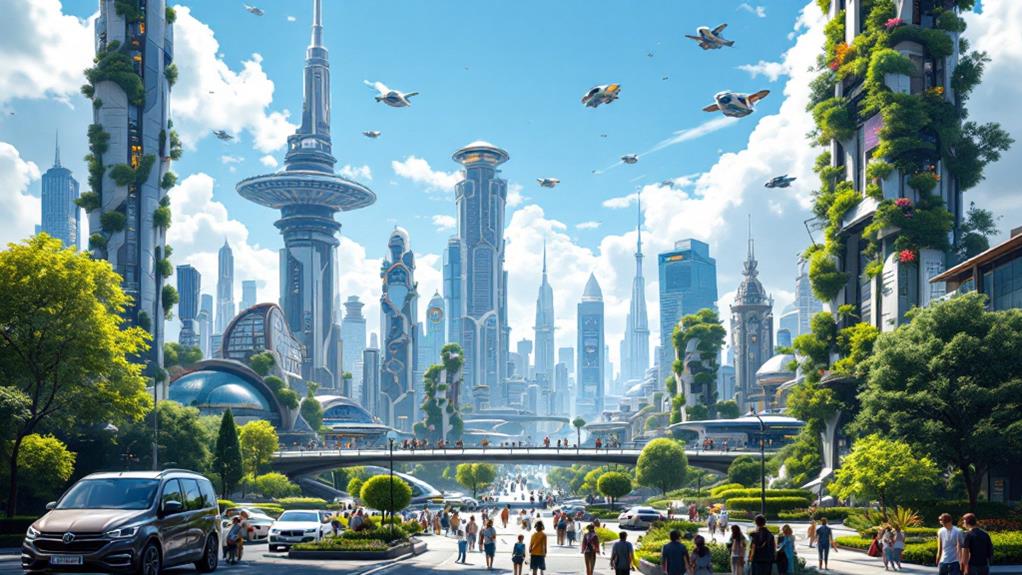
As cities continue to adopt innovations in urban living, the future of urban areas is set to be both challenging and transformative. By 2050, you'll see nearly 7 billion people inhabiting these spaces as economic forces drive more people from rural to urban regions. High-income countries already boast over 80% urban population, showcasing that urban living isn't just a trend but a global shift.
Yet, this rapid urbanization presents hurdles, particularly the growing population living in slums. Almost one in four urban dwellers reside in slum conditions, a significant barrier to achieving Sustainable Development. Addressing these issues requires thoughtful planning and innovation.
Consider these future trends:
- Increased urban migration: More people from low-income countries will move to urban areas, seeking better opportunities.
- Centralized urban growth: In some regions, especially Africa and Latin America, over 50% of the urban population may cluster in the largest cities.
- Sustainability efforts: Cities must focus on sustainable practices to improve living standards and reduce slum populations.
- Economic disparity: Balancing growth between high- and low-income countries will be crucial to create equitable urban environments.
The path ahead is complex, but with strategic efforts, urban areas can thrive sustainably.



